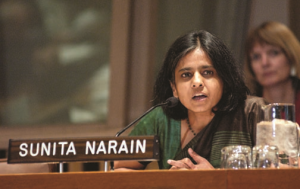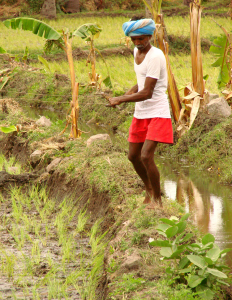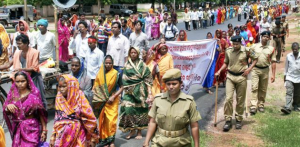Near the end of February in Down To Earth, I wrote about a fatal disconnect between the elite club exercising global economic governance, and the realities afflicting the global village itself. I noted The World Economic Forum—the gathering of power glitterati each year in Davos—had assessed the top risks the world faces in 2011. According to their analysis, climate change is the highest-ranking risk the world will face in the coming years when its likelihood and impact are combined. What is even more important are the inter-connections between climate change and the other top risks: economic disparity (ranked 3), extreme weather events (ranked 5), extreme energy price volatility (ranked 6), geopolitical conflict (ranked 7), and flooding and water security (9 and 10). The world, even according to the richest men, is in deep and desperate trouble.
This is not a past or future scenario. This is the present. The Food and Agriculture Organization (FAO) says world food prices this January hit a “historic peak”. The food price index, collated by FAO, averaged 231 points in January, which is the highest since 1990, when it started measuring food prices globally. The reasons for the spike are not just the traditional, ranging from greedy speculators to faulty future markets and rising demand. They are newer—extreme weather events, floods and draughts, heat and frost waves—and they suggest a threat even more difficult to contain.
Just consider the year gone by. In August and September, two separate grain-growing regions of the world were being impacted by extreme weather—bitter cold and frost in Canada and searing heat, fires and drought in Russia. Add to this the floods in Australia and now winter drought in China’s main wheat-growing northern regions. All of this has contributed to a depression in global wheat production and an increase in prices. Bad weather has taken its toll on crops across the world.

In India over the past two months, paddy ready to be harvested was damaged because of unseasonal rain in Andhra Pradesh and Odisha. Chili crops were hit in Tamil Nadu. Frost and extreme cold destroyed crops in Madhya Pradesh, Rajasthan and Punjab. Farmers have committed suicide over crop failures. There are many more cases of damage to crops because of changing weather.
Last year several parts of India witnessed floods. This year vast parts of Africa are facing floods as well. Droughts and floods add to the cycle of destitution because they destroy the gains of development.
We know that no single weather event can be attributed to climate change, but that the growing intensity and frequency of such events is almost certainly attributable to climate change. We must begin to understand the connection between bad weather, increased food prices that add to poverty, and the spilling global unrest. It was the spike in food prices that led to the first spark of protest in Tunisia, and has now spread across Egypt and other parts of the Arab world. Increasing food demand driven by growing population, combined with crop losses because of weather-related events, and exacerbated by poor governance, will be the tinderbox of the future. These will add to the destitution of the poorest and make global disparity starker.
Why do rich men still have their heads (and hearts) buried in the sand as far as solutions to climate change are concerned? Why is there no progress to reduce emissions? In fact, why in the world is the movement backward when it comes to this top-ranking risk?
The world has touched rock bottom as far as progress on an effective agreement on climate change is concerned. In Cancun we know there was a deliberate and successful move to dismantle the agreement to set targets on emission cuts. The cost of the agreement, stitched to please the US and its coalition of the willing, is that world leaders are now under no pressure—legal, moral or financial—to take the hard steps needed to reduce emissions. In Cancun, every party but one—Bolivia– agreed to do nothing. No one seems interested anymore.
Worse still, since Cancun, the world has moved further back on its commitment to limit emissions. Japan has crossed the line saying it will not and cannot do more; the US is currently contemplating how it can get rid of the puny little action it was taking to monitor carbon dioxide as a pollutant; Europe and the rest want to find new trade tricks to do little at home. The world is precariously placed: on the one hand the crisis is growing and becoming evident; on the other hand the response is weakening and losing urgency.
The answer to my question is not hard to find. The Davos glitterati’s assessment of global risks contains a fatal error. There is no mention, let alone appreciation, of how the current global economic system incentivizes the world’s present danger. The men who run the world (it is now accepted that the club has limited membership) have yet to acknowledge their complicity in not addressing the problem.
This is the most obvious and fatal disconnect of our times.

In May, the same month as the Davos forum, I was confronted with another set of distorted development perspectives. This latter experience occurred while on a visit to the middle of India, in Nagpur, where local politicians, conservationists, and officials were discussing what needed to be done in this chronically poor and backward region endowed with forests and tiger habitats.
The discussion began with tigers. Everybody wanted more money to protect reserves earmarked for this magnificent creature. The demand was unanimous that Nagpur should be declared the tiger capital of the country. The existing tiger reserves should be expanded, better protected; money should be paid to relocate families living in the tiger’s habitats and tiger tourism should be promoted. Clearly, there was an important constituency for the tiger, which in turn is important for protecting their forested habitat. Or so you would think.
Then the talk turned to forests. “All development has come to a halt. We cannot mine coal. We cannot build thermal power stations, roads, factories or irrigation canals. In each case we need to go to Delhi or to Bhopal (the regional office of the Ministry of Environment and Forests) because we need clearance from forest departments for each hectare (ha) of land that will be diverted.” Forests were suddenly the underlying reason for the lack of development, poverty and dissatisfaction. Tigers were loved, but forests were hated.
It is important to understand this reality. This is a region where in many districts over 80 per cent of the land is classified as forests. Throw a stone and it will hit forestland. Under the Forest Conservation Act, 1980, it was decided that the only way to stem rampant diversion of forests for development projects was to ensure that every file travelled to Delhi for clearance. Since the trip to Delhi was time-consuming, in 2003 it was agreed that in the case of projects requiring diversion of less than 40 ha of forestland the file would go to the ministry’s regional office.
No doubt this sternly worded legislation has been critical in safeguarding forests. Deforestation rates have come down. Cutting forests has become tough, as its diversion requires clearance on file, payment of its net value, and funds for compensatory afforestation.
The flip side is that in this region the people have no use for forestland. They do not see the connection that if the forests go, the tiger cannot survive. Tiger populations are increasing, but the contiguous forests which allowed the territorial tiger to roam are degraded or diverted to other uses. At this rate, the tiger will survive—because of the huge investment being made for its protection—but in increasingly smaller zones. This represents the zooification of the tiger, bounded not in city zoos but in reserves surrounded on all sides with high-level firewalls.
This is the tragedy of our forests. There is no value for the tree, but only for the land below it—for mining or development. The people who live in forests are neglected and impoverished, caught between lack of development and the hateful stick of the forest guard. Small wonder Naxalites are taking advantage of this anger.
How can one maintain the balance between forests and development? In my view, it requires a drastic rethinking of what we mean by development, and a re-positioning of forests in that development strategy.
Conventionally, the only way regions can develop is by cutting forests and building the infrastructural necessities—roads, electrical grids, sewers—that signify economic growth. This is what all of us living in non-forested zones have done. We have cut forests, then cultivated land and built factories and cities. We are rich because we have cleared the forests. The question is: how does a forested region grow with its forests, and still become rich?
At the moment India has a provision to pay the “net present value” of forests while felling trees. In other words, we pay to cut. But there is no payment for standing forests. There is no value for this resource. For many years, chief ministers have been demanding that they be paid to protect forests. Finally, the 12th Finance Commission, in 2004, agreed that states must be paid for the maintenance of forests—some Rs 1,000 crore between 2005 and 2010. Very little money, but the principle was established. However, nothing really happened. In 2010, the 13th Finance Commission reiterated the need to compensate states and enhanced the allocation to Rs 5,000 crore over the next five years. But still the money has not been provided. Equally important is that this money must go to the people who live in the forested regions. It is their burden that must be rewarded.
We also need to sustainably use the resources to build green wealth. Currently, the productivity of our forests is pathetically low. This is partly because we do not know how to plant and cut and then grow again in the face of enormous human and animal pressure on our forestland. So we plant, but regeneration is low. We cut, and then the land is degraded. How then can we build a green forest future and turn our forests into assets? It is necessary to find an honest and innovative answer to this question.
By mid-march, as the Indian people braced themselves for the rigors of the new financial year, I noted the same disconnect between the guardians of the national economy and the common public in the national scenario the finance minister had dispatched, the Union Budget for 2011. The press was busy reflecting the views of business and industry lobbies as they quibbled over duty exemptions, insisted on financial stimulus and other incentives, and cried for big-ticket reform: foreign direct investment in retail and insurance.
The only other discussion was about the growing fiscal deficit. Will the finance minister give in to populism while extending the programs for the poor? Or will he raise taxes to pay for the growing developmental needs of the country? The finance minister, it would seem, was caught between two battles: of checking the bulge in fiscal irresponsibility, and of meeting the need for delivering governance.

This budget was coming at a time when the world food prices were spiraling because of unusual and variable weather events. Oil prices, too, were rising, triggering fears of a full-blown crisis in West Asia. In this age, it is clear that fiscal prudence must take new forms of balancing books that are not cooked. To respond to this uncertain future, I suggested that the Finance Minister get serious about agricultural growth. Indian agriculture suffered because of a lack of investment. We talk about infrastructure for industrial growth, but how many times have budget pundits stopped to check how farmers irrigate their land? If they did, they would find that the bulk of irrigation facilities in the country have been created through private investment. Dug-wells and tube-wells provide water to over 60 per cent of irrigated crops. Farmers have invested money, borrowed from financial institutions, and paid hefty interests because of the high risks and lack of benefactors in high places (unlike many industries, where loan default is astoundingly high).
It is also prudent that we get serious about paying the real price of growing food, particularly in times of weather uncertainty. The government expenditure increases as the cost of food increases, particularly because of high procurement of food for distribution. In the past, governments have balanced budgets by squeezing profit margins of food growers so that government or consumers pay less for food. But this policy must change, particularly in times when growing food
itself is becoming risky because of erratic weather. One instance of extreme cold, heat, rain or drought can wipe out crops, impoverish people and push them deeper into debt and despair.
Farmers must be paid higher prices for food. The minimum support price must be raised to the maximum; it must reflect the ecological cost of food. Crops that use less water must be paid more and included in the government’s food procurement basket. It also requires investment in ecological regeneration—building soil, forest and water assets—for coping with adverse weather. Ecological prudence must be part of the fiscal responsibility package, and the budget must also build the foundations of social security so that people can cope with uncertainty. We desperately need to spend more on health, public services and education.
The governance of public-sector spending must also improve; merely spending is not enough. But how can services be efficiently delivered to the people? The impression is created that all will be well once we can identify people who need the service and give them unique, secure passkeys for identification. But in my view it is equally important to fix the broken systems of governance and delivery in the country.
It is equally important that spending and subsidy are targeted at the poor, and the rich do not siphon them off. Take diesel. its price is kept low for the poor even in times of high oil prices. But it is being used to drive the vehicles of the rich. The government’s own estimate is that more diesel is used in private passenger vehicles (15 per cent) than in agriculture (12 per cent). This, when we know that there is huge under-recovery in the price of every liter of diesel sold in the country.
The supposed reformers will talk about withdrawing subsidy on all fuels, while well aware of the fact that a large number of people in India cannot even afford the cheap and subsidized kerosene. The poor need access to subsidized fuel; its diversion to cars is pilferage. My plea to the Finance Minister was to ban its misuse.
From my experiences in India I’d like to present three more instances of indifference towards common people and their productivity, characterized by a persistent over emphasis on monetary growth and high technology, which is continuing to distort the development outlook of the global village. The first example was experienced by me last May. We were on a beach somewhere close to Puducherry (in Pondicherry). The sight was surreal: half-smashed houses with wide open fronts, people still living in them. The devastation was caused not by a sea storm or a cyclone, but by the eroded beach. The sea had crept up to the village; there was no protection between the sea and the village.
“Why is this happening?” I asked. My guides were members of the Pondy Citizens’ Action Network (PondyCAN), which has worked tirelessly to bring beach erosion to national attention. To understand this, we walked a little distance away. From the beach, I could see massive granite stones piled up to build a groyne stretching into the sea. This structure, made to protect villages from erosion, ends up with protecting one village, but destroying another, explained my guides.
But I still could not see the connection. How could one small structure like this change coastal ecology? Then I got a lesson of my life. Civil engineer Probir Banerjee and marine engineer Aurofilio Schiavina explained that a beach is not just a lot of sand. “Beaches are rivers of sand” because each year the waves transport huge quantities of sand from north to south and from south to north. During the southwest monsoon some 600,000 cubic meters of sand is moved towards the north, and in the three months of the northeast monsoons (when winds are fierce) 100,000 cubic meters are transported towards the south across the eastern coast of the country.
So beaches are living creatures—winds and waves bring sand in one season and take it away in another. My teachers further explained marine science to me: “Then, think of the groyne as a dam in a river which will block the movement of sand, not water.” In this case, the groyne has stopped the movement of sand to the beach ahead. This beach does not grow and when the wind changes, the monsoon gets fierce, the sea moves in, and there is no beach to protect the land beyond.
The lesson was not finished yet. Our next stop was the Puducherry harbor, with a breakwater fingering its way into the sea to protect the boats. This structure, built in 1986, marked the beginning of devastating changes in the coast. Once the harbor was built, it first changed the beach closest to it—the beach along the city of Puducherry.
“I played on the beach as a child,” said V Narayanasamy, member of Parliament from Puducherry and minister of state in the Prime Minister’s Office. “What beach?” I asked. All I could see was granite stones piled along the ocean promenade. By then it was evening. People had gathered, as they do to enjoy the beach and the sunset. But there was no sand or beach. Only rocks. All this had been lost in a living memory of 15-20 years. A people had lost their playground. More importantly, a city had lost its critical ecosystem, which would protect its land and recharge its groundwater. And fishers had lost their livelihood.
This is just the beginning, explained Banerjee. This structure, small by any standard of modern harbor or port, has spun a chain of beach changes along the coast. The groyne we saw earlier had been built because the length of the coast stretching 10-20 km was now destabilized. We could see piles of sand accumulated before the harbor, blocked from making its way to regenerate the beaches. Now every beach needs a groyne and every groyne adds to the problem of the next beach.
Besides, just think of the amount of granite that is brought from long distances after destroying hills, and the carrying trucks adding to nasty pollution. Just think how much is being lost only because we cannot plan to mitigate damage.
This is the key message. Ports are interventions to the natural ecology of coasts. But we neither understand the impacts, nor worry about ways to deal with the damage. A few years ago, Puducherry woke up to the reality that their harbor was to be rebuilt and contracts and concessions had been awarded to transform it into a massive port (with capacity to handle 20 million tons of cargo a year). The citizens’ group went to court against the project. But the developer—strangely enough, with no experience in ports, but in building shops and malls—is not letting go. This is a sweet deal, which brings real estate benefits as the port concession package comes with cheap city land bundled in for recovery of cost.
In this stretch of some 600 km, one can count seven ports that exist and another three are proposed. This is when each existing port is not used to capacity and is being upgraded big time. Then why are we building more ports? Is this development or a land-grab?
There is no policy for siting and number of ports in the country. The Central government knows only about “major” ports and leaves the rest of the business—permission to locate and build other ports—to state governments. There is no distinction between a major port and a state port. It is just a matter of how many one can fit into the coast as fast and profitably as possible. Nobody, therefore, knows how many ports are being built. Nobody cares about the cumulative impact on rivers of sand.
Surely, this cannot be called development. Can it?
The last example that I shall put forward is at once most tragic in terms of drive, as well most inspiring as proof of the power of human spirit. The sights on television were heartbreaking: children lying in rows in the searing sun to be human shields against the takeover of their land for Korean giant POSCO’s mega bucks project. Facing them were armed police sent by the state government to assist in the operation.
 The steel plant and port project, located in a coastal district of Odisha, has been in a six-year-long eyeball-to-eyeball battle with people whose land will be acquired. Now with clearances coming through , the state government wants the land acquired at seemingly any cost. It has put a financial offer on the table, which even pays for encroached government land. It believes this is a lifetime offer people should now accept. Move on; let the project be built and precious foreign investment come to the shores of this poor state.
The steel plant and port project, located in a coastal district of Odisha, has been in a six-year-long eyeball-to-eyeball battle with people whose land will be acquired. Now with clearances coming through , the state government wants the land acquired at seemingly any cost. It has put a financial offer on the table, which even pays for encroached government land. It believes this is a lifetime offer people should now accept. Move on; let the project be built and precious foreign investment come to the shores of this poor state.
The question we need to ask once again is why people who look so obviously poor are fighting this project. Why won’t they accept the financial compensation, which gives them an opportunity to start a new life and spare their children the drudgery of growing betel nut? Is it growth and development versus environment or just uninformed, illiterate people or even politically motivated agitators? Is it really as simple as that?
I am afraid not.
POSCO is about growth versus growth. People here are poor but they know that this project will make them poorer. This is the fact that we in the modern economy find difficult to comprehend. This is an area of betel farming done on mostly forestland belonging to the state. Of the 1,620 ha needed for the project 90 per cent, or 1440 ha, is this contested forestland.
When the project site was selected, the government did not consider it would have to pay compensation for this land—it was encroached upon by the people, and the government would simply take it back for the steel giant. But it was forestland, and the people who lived there had cultivated it for as long as they could remember. This then raised the tricky matter of the conditions under the Forest Rights Act that require people to give their consent to the project. The Union Ministry of Environment and Forests overruled its own dissenting committee to say it would have to trust the state government’s version that all procedures were followed in determining that people in these villages were not entitled to this right to decide because they were not traditional forest dwelling community.
With this sorted, environmental and forest clearance was granted. Land acquisition for the project could proceed. But people who were not asked still said no.
Why? After all, the state government says it has accommodated all demands in its offer. It has agreed to limit the acquisition of private dwellings and village land.
People will still have homes; they will only lose livelihood. But even that will be compensated. It has agreed to pay for the loss of the use of forestland, even though technically people have no rights over it. The farmers will be paid, according to field reports from Odisha, some Rs 28.75 lakh for each ha of “encroached” betel farmland. Then the package includes provision for payment to wage earners, who will lose livelihood when betel farms go. The severance pay has a sweetener. The government will pay a stipend, limited to a year, for the period people look for “jobs”. In addition, the 460-odd families who lose homes will be resettled in colonies. So why is this generous offer being rejected?
Is it only because of the obduracy of a few people, namely the leaders of one gram panchayat, Dhinkia? This village has locked out the administration for the past three years. All roads to it are barricaded. It is a mutiny, fierce and determined. This village holds out alone because its gram panchayat covers some 55 per cent of the land earmarked for the steel plant, its captive power plant and its private port project. Two other gram panchayats are involved, but their loss is smaller and their leadership is not so strong. But my colleague who visited the residents of the villages waiting in a transit camp for their new houses to be built and handed over, found discontent brewing. Where is our livelihood, people asked? What will we do?

These questions are at the core of the battles raging across the country wherever land is being taken for development, but people are losing livelihoods. In yet-to-be POSCO-land, betel farming earns Rs 10-17.5 lakh per ha per year. The compensation is equal to two to three years of earning. In addition, there is the earning from paddy, fish ponds and fruit trees. This land-based economy is employment-intensive. The iron and steel plant, however vital for the nation’s economic growth, cannot provide local employment. For one, local people are not “employable” in such a plant. Two, this modern state-of-the-art plant needs only a limited number of people in its operations.
POSCO is then about growth versus growth. It is just we who have discounted this economy of the land for so long in our understanding of what works and what matters. It we who have forgotten that development cannot be development if it takes the lives of the very people for whom it is meant. The message is clear: if we want their land, we will have to give them a life. ■
————————————————————–
Sunita Narain is Director General of Center for Science and Environment, New Delhi, and editor-publisher of the 20 year-old fortnightly, Down to Earth.

